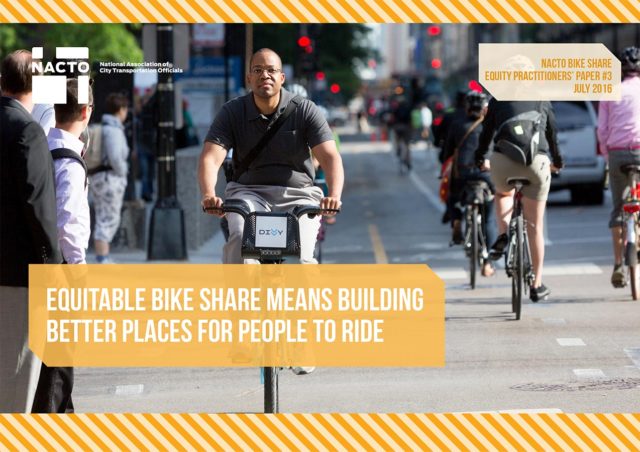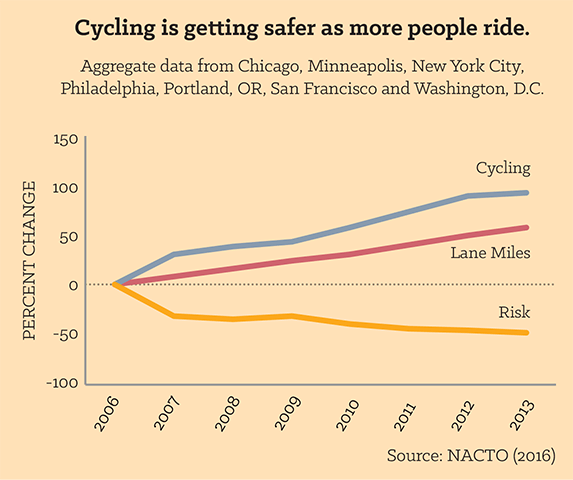NACTO research in seven cities shows that pairing bike share with protected bike lanes encourages riding, increases the visibility of people on bikes, and reduces overall biking risk

For Immediate Release
July 20, 2016
Press Contact:
Alexander Engel
[email protected]
646.324.2919
As cities across the U.S. build comfortable, protected bike lane networks, the number of people biking is going up and the risk of death or injury to each individual bike rider is declining, new research from NACTO shows. In an analysis of seven U.S. cities, NACTO’s third Equity Practitioners’ Paper looks at the relationship between building bike lanes and bike safety, and finds that municipal policies that encourage bicycling, like introducing large-scale bike share programs, make it safer for everyone on a bike.
NACTO’s latest report, Equitable Bike Share Means Building Better Places for People to Ride (pdf) combines in-house research with analysis of other reports, and finds that:
- Riding a bike is getting safer as cities build better bike lane networks. In five of the seven U.S. cities NACTO surveyed, the absolute number of bicyclists killed or severely injured declined from 2007 to 2014, even as bike ridership rates increased. Additionally, even in the cities where the absolute number of bicyclists killed or severely injured increased over the time period, that rate is rising at a slower pace than the increase in bicycling itself. This decline in risk comes at the same time as bike ridership rates in the cities surveyed have more than doubled. All seven cities have invested in high-comfort bike facilities.
- Gains in bike safety are especially important for low-income riders and riders of color. 49% of the people who bike to work earn less than $25,000 per year, and Black and Hispanic bicyclists have a fatality rate 30% and 23% higher than white bicyclists, respectively. Building extensive protected bike lane networks benefits those who are most at risk.
- More people ride when cities build protected bike lanes. Studies from cities across North America show that adding protected bike lanes significantly increases bike ridership on those streets, with rates ranging from 21% to 171%.
- Most people are “interested but concerned” about biking and would bike with higher-comfort facilities. 60% of the total population are “interested but concerned” about biking. Of those, 80% would be willing to ride on streets with a separated or protected bike lane. In particular, recent national research suggests that that people of color are more likely than white Americans to say that adding protected bike lanes would make them ride more.
- Bike share systems should be matched with extensive protected bike lane networks to encourage ridership and increase safety. People on bike share bikes make up a disproportionate number of the riders on protected lanes, and stations adjacent to bike lanes are busier than ones that are not. For bike share to be successful, people need to feel comfortable riding.
- Bike share programs increase the visibility of cyclists, making riding safer for everyone. The risk of a bicyclist being struck by a motorist declines as the number of people biking increases. Appropriately scaled bike share systems can dramatically increase the total number of people on bikes in a city and help build political momentum for bike lanes.
- Mandatory adult helmet laws reduce bike ridership and don’t increase safety. Mandatory adult helmet laws have reduced bike ridership in Sydney, and hampered bike share ridership efforts in Melbourne and Seattle. In addition to evidence that mandatory adult helmet laws do not increase overall bike safety, reports from across the U.S. suggest that these laws are disproportionately enforced against people of color, further discouraging them from riding.
- Long-term engagement efforts, done by and with communities, can build support for necessary safety improvements. Widespread local support often exists for bike lane and safety projects. As seen in Los Angeles, cities can build support for safety projects by engaging in long-lasting partnerships with local organizations and simultaneously addressing wider community concerns such as police training around cycling enforcement. This organizing and engagement work is essential for safe streets.
“NACTO cities are leading the way on safety and this new analysis makes it clear why,” said Seleta Reynolds, General Manager of the Los Angeles Department of Transportation and NACTO President. “Each new facility we put down multiplies our investment in our city streets. High-quality bike lanes attract riders and are essential to increased safety for everyone.”
“People want and need safe places to walk and bike, and safe ways to get to their jobs or schools,” said Carniesha Kwashie of the Mayor’s Fund for Philadelphia and the Grant Manager of the Better Bike Share Partnership. “This analysis by NACTO highlights the fundamental fact that building safe streets underscores all approaches to building a more equitable city and society.”
“As we launch BIKETOWN, we do so knowing that we have built a strong foundation for a successful system: a large network of high-quality bike lanes,” said Leah Treat, Commissioner of the Portland Bureau of Transportation. “Our safety record, like that of our peer cities, is the result of hard work and focus and the City of Portland is proud to be recognized as a leader.”
“Not only is building better bike lanes and supporting them with long-term community engagement essential for safety, it’s also an important step on the path to a more equitable bike infrastructure,” said Tamika Butler, Executive Director of the Los Angeles Coalition. “Cities should use NACTO’s latest research to double-down on building high-quality bike facilities, narrowing the safety gap for our historically neglected and most vulnerable road users.”
“Motivate and the hundreds of thousands of people who ride our bike share systems each year value having safe places to ride,” said Jay Walder, President & CEO of Motivate. “From New York to Portland and in between, the cities where we operate have invested in building more safe bike infrastructure and we are glad that our bike share systems can help contribute to safety in numbers as well.”
“NACTO’s analysis confirms our experiences helping cities build protected bike lanes through our Green Lane Project,” said Martha Roskowski, Vice President of Local Innovation at PeopleForBikes. “People of all ages and abilities, genders, ethnicities, and incomes show up when cities create safe and comfortable places to ride. By connecting the dots between better infrastructure, bike share, safety, and better communities, NACTO has created a valuable resource for cities and supporters everywhere.”
Equitable Bike Share Means Building Better Places for People to Ride (pdf) is the third in NACTO’s Equity Practitioners’ Paper series, which highlights best practices for cities aiming to address equity issues while introducing or expanding their bike share systems. All three papers, along with additional resources, can be downloaded free of charge at nacto.org/bikeshare.
###
About NACTO
NACTO is an association of 46 major North American cities formed to exchange transportation ideas, insights, and practices and cooperatively approach national transportation issues.
Member cities include Atlanta, Austin, Baltimore, Boston, Charlotte, Chicago, Denver, Detroit, Houston, Los Angeles, Minneapolis, New York, Philadelphia, Phoenix, Pittsburgh, Portland, San Diego, San Francisco, San Jose, Seattle, and Washington D.C. Affiliate member cities include Arlington VA, Boulder, Burlington, Cambridge, Chattanooga, El Paso, Fort Lauderdale, Hoboken, Indianapolis, Louisville, Madison, Memphis, Miami Beach, Montreal, Oakland, Palo Alto, Puebla MX, Salt Lake City, Santa Monica, Somerville, Toronto, Vancouver BC, Vancouver WA, Ventura, and West Hollywood.
About the NACTO Bike Share Initiative
Bike share has rapidly emerged as a new transportation option that can bolster public transit usage and increase cycling, with systems in in over 50 U.S. cities. As cities and towns around the country focus on sustainability and equity, bike share systems can play an important role in safety, accessibility, and livability efforts by making it easier for people to get around. To facilitate conversations between peer cities, NACTO holds roundtables, workshops, and webinars and conducts research on best practices and challenges for the growing bike share movement.
NACTO is a member of the Better Bike Share Partnership, a JPB funded collaboration between The City of Philadelphia, Bicycle Coalition of Greater Philadelphia, NACTO, and PeopleForBikes, to build equitable and replicable bike share systems.
For more information about NACTO’s Bike Share Program, contact Kate Fillin-Yeh, NACTO Bike Share Program Director, at [email protected].